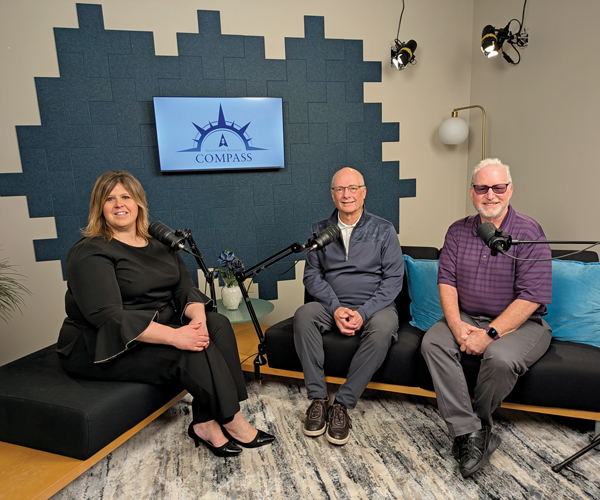Nursing is the most trusted profession in the world, according to Jason Pirtz, chief nursing officer for University Hospitals (UH) Cleveland Medical Center, citing 2021 studies to back up his claim. People look to nurses more than anyone else in the medical world or in any other profession to be honest, do their best to provide medical care and treat patients as individuals.
“We’ll take that recognition,” says Pirtz, who holds a master’s degree in business administration and has been a registered nurse for 22 years. “It’s been a couple of rough past years.”
We know why — the COVID-19 pandemic, long hours at work, understaffed facilities and even violence against nurses. But nursing stands firm as one of the careers that matter in several ways.
For many nurses, it’s the fulfillment and satisfaction that they make a difference in the lives of patients and their families that attracts them to the profession or keeps them in the game. What’s more, being able to command a better than average salary and often a flexible schedule, as well as work in a variety of environments in an infinite number of locations means nursing can be a lifetime choice.
“The nursing profession pays solid wages, which is critical — and rare — for a profession that disproportionately employs women,” according to the Center for American Progress, an independent, nonpartisan policy institute.
Greater Cleveland, with its amazing medical and health care facilities, is a hot bed for opportunities. The nursing partnerships and affiliations between educational facilities and employers in the region are among the best in the country, according to local experts. Opportunities also exist for Cleveland area nurses in corporations, professional and amateur sports teams and facilities, educational institutions, assisted living and skilled nursing home environments, correctional institutions, entertainment venues, the lodging industry and more.
“Nursing programs in Northeast Ohio have the opportunity to partner with internationally, nationally and/or regionally recognized agencies,” says Penni Rolen, president, Greater Cleveland Nurses Association. “Within the city, there has been a long history of collaborative efforts to bring practice and educational leaders together. Not only are outstanding clinical experiences provided, but collaboration has led to innovative curriculum strategies to better prepare students and graduates.”
Positive Partnerships
The MetroHealth Department of Nursing provides student nurses from Case Western Reserve University, Chamberlin University, Kent State University (KSU), Cleveland State University (CSU), Lakeland Community College, Cuyahoga Community College (Tri-C), Notre Dame College and others, with clinical and practicum experience. A nurse intern position allows participants to learn and provide fundamental care for patients while they are still in school.
“Working hours are very flexible. The goal is to help students transition to their first nursing opportunity at MetroHealth once they are ready,” says Katrina Kelley, manager, nursing education and professional development. “For experienced nurses coming to MetroHealth, we have resources to help them increase their certifications, as well as professional development opportunities.”
Kelley says MetroHealth System’s commitment to the community is especially attractive to nurses who hear that calling. The system has school-based health partnerships with Cleveland Metropolitan School District to meet the needs of students, as well as a community nurse/family partnership to assist mothers who are expecting.
Wendy Batch-Wilson, dean of the nursing center of excellence at Tri-C, praises her school’s “full career ladder” approach to nursing education as a huge advantage for nursing students. Its structure allows students to “step out” at several points in their education and sit for state exams to become a nursing assistant and LPN, ultimately earning an associate degree in nursing to sit for RN licensure. Tri-C’s agreement with CSU for advanced studies offers tuition reduction and scholarship dollars to support earning a bachelor’s degree.
A nurse educator for 20 years, Batch-Wilson says Tri-C’s multiple campuses across the county make it convenient for students to attend classes and for employers to find nursing interns and employees nearby.
She urges Northeast Ohio employers to give nursing students the opportunity to be employed while they are still in school to “get exposure to nursing while getting paid.” She also suggests employers offer flexible schedules so students have time to attend classes and study, leading to their successful program completion.
KSU is one of the “largest and most respected nursing schools in the country,” according to Versie Johnson-Mallard, dean, professor and Henderson Endowed Chair of the College of Nursing. The school boasts almost 16,000 alumni worldwide. KSU’s “key players” in clinical partnerships include UH, Summa Health System, Cleveland Clinic and MetroHealth. Eighty percent of the school’s freshman nursing class are Ohio residents, 19% are non-Ohio residents and 1% are international students.
KSU’s five campuses annually offer about 3,000 nursing students courses at the bachelor’s, master’s and doctoral levels. For the third term, the National League for Nursing named the college as a Center of Excellence in the category of advancing the science of nursing education. The designation extends from 2022 to 2026.
“When I first came here a year ago, I was invited to tour Cleveland Clinic. One of the persons who led the tour was a young KSU grad who was already in leadership even though she has been a nurse less than seven years. She was in a high-level position because she stood out among others. It was such a privilege to meet this young adult,” says Johnson-Mallard, reflecting on both the student’s personal abilities and KSU’s nurses training programs.
UH’s Pirtz notes that, of course, his health system looks for the best and the brightest of nurses when hiring. He also recognizes that nurses “who advance their degrees increase their expertise overall.”
“But we also want people who care about people. It’s all about being compassionate and providing the highest level of respect and care,” says Pirtz, adding that “hundreds of nursing students have completed their clinicals at UH,” and that professional development for nurses, including UH’s Professional Pathway program, help employees grow professionally.
“It’s not out of the normal to have those types of programs,” says Pirtz. “But ours are very well developed.”
Collaborations among nursing schools have become even more important since the pandemic disrupted clinicals and in-person learning and created teacher shortages. Local schools collaborate to ease those gaps. For example, Ursuline College in Pepper Pike and John Carroll University (JCU) in University Heights have agreed that at least two slots per year in the Breen School of Nursing at Ursuline College’s accelerated BSN program are reserved for JCU graduates.
Also, Northeast Ohio nursing schools and regional employers are joining forces to provide significant tuition reimbursement and other incentives to encourage more individuals to consider a nursing career, graduate and then join the specific connected medical facility. Students frequently choose to work in the environment where they complete their clinical experiences because of familiarity, networking and relationships formed with other staff members.
Addressing the Nursing Shortage
The stats about the nursing shortage now and in the future are alarming. The country is facing a shortage of between 200,000 and 450,000 nurses by 2025 — a shortage of between 10% and 20% of nurses needed to care for patients, according to McKinsey and Co., a global national consulting and advisory firm.
“Enrollment for all nursing programs is down overall,” says Pirtz. It’s not that we could have just one creative solution. We are looking at different strategies for what we call the Care Team of Tomorrow to make sure we are supportive from all angles.”
Pirtz says UH’s concerns are similar to national trends that currently show the most need is for critical care nurses.
“However, the trend is more toward ambulatory care. That is a highly desired role for our current nursing professionals,” says Pirtz. “A lot of it relates to work/life balance. Perhaps the ambulatory setting is more desirable because it’s not a 24/7 effort. We are a firm believer in creating a healthy work environment for all our nurses, who are equal partners in our team at UH. Our environment allows them to work autonomously with the resources they need to be successful.”
“The nursing shortage is at the top of everyone’s mind,” claims MetroHealth’s Kelley. “But it’s also about what we can do to support and retain our staff.”
KSU’s Johnson-Mallard warns that it isn’t just a matter of pushing out more graduates. The skills and knowledge that students at all nursing certification levels need to pass state and national nursing exams take time to learn, she says.
“Society needs our students to graduate as fast as possible, but knowledge and preparation take time. Our students graduate with the qualifications to meet today’s health care needs, a tradition for which KSU is widely respected.”
Another problem is that “higher compensations in clinical and private settings is luring current and potential nurse educators away from teaching,” according to the Ohio Nurses Association.
It cites American Association of Nurse Practitioners statistics that indicate the average salary of a nurse practitioner across settings and specialties is $110,000. In 2020, the average salary for a master’s prepared assistant professor in schools of nursing was $79,444. Fewer nurse educators means fewer classes.
“Nursing is very important. We are a bridge between patients, family and health providers,” says Kelley.




